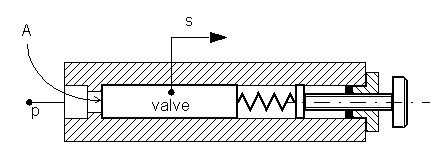Hydraulic Single-Acting Valve Actuator
(To be removed) Single-acting hydraulic valve actuator
The Hydraulics (Isothermal) library will be removed in a future release. Use the Isothermal Liquid library instead.
For more information on updating your models, see Upgrading Hydraulic Models to Use Isothermal Liquid Blocks.
Library
Valve Actuators
Description
Use the Hydraulic Single-Acting Valve Actuator block as a pilot actuator for directional, pressure, or flow control valves in applications where all the forces, except spring force, and flow consumption can be neglected.

The actuator consists of a piston and a spring. The spring, which can be preloaded, tends to keep the piston at the initial position. As pressure applied to the piston develops enough force to overcome the spring preload, the piston moves to the opposite position until it reaches its maximum stroke.
The actuator is simulated according to the following equations:
where
| p | Pressure applied to the piston |
| s | Piston displacement |
| A | Piston area |
| F | Instantaneous spring force |
| Fpr | Spring preload force |
| Fmax | Spring force at maximum piston displacement |
| stroke | Piston stroke |
| or | Actuator orientation with respect to the globally assigned positive direction. If pressure applied at port X moves the piston in positive direction, or equals 1. If pressure applied at port X moves the piston in negative direction, or equals –1. |
Connection X is a hydraulic conserving port associated with the valve chamber. Connection P is a physical signal port whose output corresponds to piston displacement. Pressure applied at port X moves the piston in the positive or negative direction, depending on the value of the Actuator orientation parameter.
Basic Assumptions and Limitations
No loading, such as inertia, friction, hydraulic force, and so on, is taken into account. The only force considered is a spring force.
No flow consumption associated with the piston motion, leakage, or fluid compressibility is taken into account.
Parameters
- Piston area
Effective piston area. The default value is
2e-4m^2.- Preload force
Spring preload force. The default value is
20N.- Full stroke force
Force necessary to move the piston to maximum stroke. The default value is
70N.- Piston stroke
Piston stroke. The default value is
5e-3m.- Actuator orientation
Specifies actuator orientation with respect to the globally assigned positive direction. The actuator can be installed in two different ways, depending upon whether it moves the piston in the positive or in the negative direction when pressure is applied at its inlet. If pressure applied at port X moves the piston in the negative direction, set the parameter to
Acts in negative direction. The default value isActs in positive direction.
Ports
The block has the following ports:
XHydraulic conserving port associated with the valve chamber.
PPhysical signal port that outputs piston displacement.
Examples
The following example shows a model of a pressure-relief valve built using the Hydraulic Single-Acting Valve Actuator and Orifice with Variable Area Round Holes blocks.


